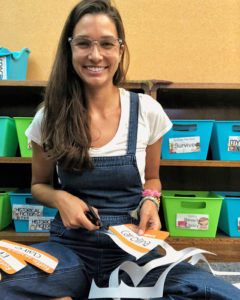This blog post was written by NCTE member Ashlan Bishop.
When I made a mistake in my classroom, I used to announce a “teacher fail.” My kids would repeat this phrase, laughing along with me. If you don’t already do this—try it! It normalizes mistakes for your students and also just makes you feel better when you inevitably make a grammar error on your beautiful noun anchor chart.
Here’s one of my early teacher fails. My first year in the classroom, I read a book about kindness to my class, The Jelly Donut Difference. Social-emotional learning activities were my jam (pun fully intended), so I was always trying to think of engaging lessons to support our goals in this area. Also, I have a mean sweet tooth. Obviously, I picked up jelly donuts on the way to school. Two things were flawed with this plan: 1) Not having kids of my own, I didn’t realize many young children do not like the jelly-filled variety. Stick to the glazed or frosted crowd-pleasers. And 2) My district explicitly did not allow donuts in the classroom. In all the newness of first-year-teacher life, I missed that memo. Whoops! Teacher fail.
Donuts aside, food treats can be a fun surprise that many teachers bring for their students to make the school day a little happier. Teachers really rock. In no month is this probably more likely than February, where the store displays are filled with Valentine’s treats in convenient packs. Over the years, though, I’ve learned that this specific joy can be pretty temporary and often comes with a lot of added sugar and a collective crash. Bringing smiles into your room can also be accomplished by leading with love for your students in writing. If you are also seeking out donut alternatives, here are four ways that I found to incorporate joy through words of affirmation in my classrooms:
1. Desk notes
My favorite thing to do is leave notes on students’ desks for them to find in the morning or after returning to the room. I try to make them specific and unique, but they don’t need to be anything time consuming or lengthy. The novelty of writing on the desk is fun, and the quick hit of positivity can be used strategically to motivate (test time!) or randomly for building relationships. If your desks don’t take dry erase markers like this, you could use sticky notes instead.
2. Individual messages (paper or email)
I am a graduate student, and earlier this year a professor emailed me a compliment about a blog post I had written for class. As an almost 30-year-old adult, I still called and told my parents. We don’t lose the need for individual positive feedback. Whatever level you teach—even if students may not express the outward glee a first grader does at getting a note from a teacher—this form of care is meaningful. This is also a great time to get specific with what you see and love in a student. To break it down, I often would keep a checklist and aim to write a least one personal note to each student by the end of the semester. It’s more manageable when spaced out and operationalized.
3. Pencil affirmations
I taught elementary level, so the specific words may need to be adapted to older students. However random, encouragement written on classroom-shared supplies creates a supportive climate and may snag you a smile when a student reaches for a pencil. Affirmations become the powerful stories we tell ourselves, and leading students to make those narratives positive can be modeled through this strategy. I’ve also seen teachers have students themselves select and write these.
4. Hidden notes in books
As a lover of books, I always tried to do whatever I could to make reading a positive experience. One of my favorite ways to do so was to hide a few little notes in some classroom library books. Obviously these will need to be more general, but the randomness can be a fun surprise. This is a great spot to incorporate humor with a funny pun or meme, too. I found my students would usually excitedly show a classmate when they discovered a note, which would in turn fuel more interest in our library. The best kind of bonus!
Whatever you choose to do to foster joy, I hope it also fuels your teacher morale, too. Making the classroom a positive, supportive place can result from small actions taken consistently. There are so many ideas on social media from teachers beyond this list—try finding one that fits your needs.

Ashlan Bishop is a doctoral student in the Department of Teaching and Learning at The Ohio State University interested in equity-focused pedagogies and arts-based instruction. She previously was an elementary school teacher in Florida. She can be reached at ashlanbishop@gmail.com.
It is the policy of NCTE in all publications, including the Literacy & NCTE blog, to provide a forum for the open discussion of ideas concerning the content and the teaching of English and the language arts. Publicity accorded to any particular point of view does not imply endorsement by the Executive Committee, the Board of Directors, the staff, or the membership at large, except in announcements of policy, where such endorsement is clearly specified.

